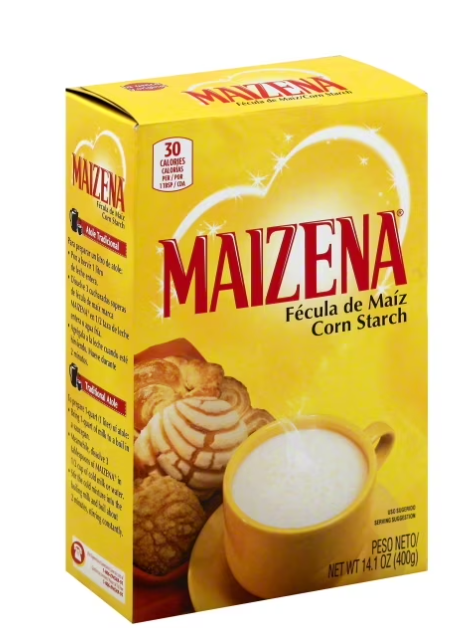
Maizena Unflavored Corn Starch Powder, 14.1 oz Regular Box
- Maizena Corn Starch is perfect for all your baking and cooking needs
- A nearly flavorless thickener, Maizena Corn Starch allows the natural taste of food to shine through.
- Use to make soft and fresh cakes
- Use to make thicker sauces
- Use to make juicy and tender meat recipes
- Use to make rich and frothy breakfast shakes
Unlocking Culinary Possibilities with the Perfect Neutral Thickener
In the vast world of cooking ingredients, few products offer the versatility and reliability of Maizena Sin Sabor. This unassuming white powder has quietly revolutionized kitchens across Latin America and beyond, proving itself as an indispensable ally for both amateur cooks and professional chefs alike. Today, I’m diving deep into everything you need to know about this pantry staple—from its humble origins to its countless applications that might just transform your cooking forever.
The Foundation: Understanding Maizena Sin Sabor
Let’s start with the basics. “Maizena Sin Sabor” translates to “flavorless corn starch” in English, and that’s precisely what it is—cornstarch marketed under the brand name Maizena (owned by Unilever) that’s particularly popular throughout Latin America and many Spanish-speaking countries. The “sin sabor” designation specifically highlights its neutral flavor profile, making it ideal for culinary applications where you want thickening power without altering the taste of your dish.
Maizena Sin Sabor begins its life as corn, which undergoes processing to extract its pure starch content. The result is a fine, powdery substance that’s remarkably effective at absorbing liquids and creating structure in foods. Its neutral flavor profile means it won’t compete with or mask the natural flavors of your ingredients—instead, it simply works its textural magic while staying taste-invisible.
What makes Maizena particularly special in the pantheon of kitchen ingredients is its extraordinary versatility. This single ingredient can transform the texture of virtually any dish without changing its flavor profile, which is a quality few other cooking ingredients can claim. From savory gravies to delicate desserts, from crispy coatings to silky puddings—Maizena adapts to whatever culinary challenge you present it with.
The Culinary Chameleon: Cooking Applications
The applications for Maizena Sin Sabor in cooking are so extensive that once you start using it regularly, you’ll wonder how you ever managed without it. Let’s explore some of the most common and beloved uses:
The Master Thickener
Perhaps the most recognized use for Maizena Sin Sabor is as a thickening agent for liquids. When added to hot liquids, it creates a remarkable transformation, turning thin, watery substances into rich, velvety ones. Unlike flour, which can leave a somewhat pasty flavor and cloudy appearance, Maizena thickens with clarity and without flavor interference.
To properly use Maizena as a thickener, there’s a crucial technique to master: creating a slurry. Simply mixing the powder directly into hot liquid is a recipe for disaster, resulting in those dreaded lumps that no amount of whisking can remedy. Instead, create a smooth slurry by first mixing Maizena with a small amount of cold water or other room-temperature liquid. This pre-dissolving step ensures the starch granules separate before hitting your hot mixture, resulting in perfectly smooth incorporation.
For soups and sauces, the general rule is about 1-2 tablespoons of Maizena per cup of liquid, depending on how thick you want the final product. Remember that Maizena continues to thicken as it cools, so it’s often wise to slightly undershoot your target consistency while the mixture is still hot.
The Crispy Coating Creator
Beyond thickening, Maizena Sin Sabor excels at creating crispy textures when used as a coating for fried foods. Whether you’re making classic Latin American dishes or experimenting with Asian-inspired recipes, a light dusting of Maizena creates a delicate, crunchy exterior that browns beautifully without absorbing excess oil.
For particularly crispy results, try the velveting technique commonly used in Chinese cooking: marinate bite-sized pieces of meat in a mixture that includes Maizena, then briefly blanch in hot oil or water before completing the cooking process. The result is incredibly tender meat with a silky exterior that holds sauces perfectly.
The Baking Magician
In baking, Maizena Sin Sabor works wonders for creating delicate textures. Substituting a portion of regular flour with Maizena results in more tender cakes, cookies, and pastries. The lack of gluten in cornstarch means it won’t contribute to the development of tough, chewy textures that can sometimes plague baked goods made with all wheat flour.
Traditional Latin American treats like alfajores—those heavenly sandwich cookies filled with dulce de leche—typically incorporate Maizena in the dough to achieve their characteristic melt-in-your-mouth texture. The same principle applies to shortbread, which gains its distinctive crumbly-yet-tender consistency from the inclusion of cornstarch.
Beyond Basic Applications: The Recipe Collection
Now that we understand the fundamental uses of Maizena Sin Sabor, let’s explore some specific recipes and applications that showcase its remarkable versatility.
Atole: The Comforting Beverage
Atole is a traditional warm beverage from Mexico and Central America that relies heavily on Maizena for its characteristic thickness. This comforting drink, often flavored with cinnamon, vanilla, fruit, or chocolate (in which case it becomes champurrado), has been enjoyed for centuries as a breakfast or evening treat.
To prepare basic atole, combine 4 cups of milk, 1/2 cup of Maizena Sin Sabor (first mixed with a little cold milk to form a slurry), 1/4 cup of sugar, a cinnamon stick, and a teaspoon of vanilla extract. Cook over medium heat, stirring constantly until the mixture thickens to your desired consistency. The Maizena creates a smooth, rich texture that holds warmth beautifully, making atole the perfect comfort drink for chilly evenings.
Flawless Gravy Without Flour
For those avoiding gluten, Maizena Sin Sabor is the perfect alternative to flour in gravies. After roasting meat, deglaze the pan with broth or wine, then add a slurry of Maizena and cold water. Bring to a simmer while stirring, and within minutes, you’ll have a glossy, perfectly thickened gravy without the sometimes pasty flavor that flour can impart.
The ratio for substituting Maizena for flour in gravies is typically 1:2—meaning if a recipe calls for 2 tablespoons of flour, you’ll use just 1 tablespoon of Maizena to achieve similar thickening power.
Silky Puddings and Custards
Maizena Sin Sabor forms the backbone of many traditional puddings across Latin America. From manjar blanco in Peru to natilla in Colombia and Costa Rica, these creamy desserts showcase cornstarch’s ability to create velvety textures without overwhelming other flavors.
A basic vanilla pudding made with Maizena involves heating milk with sugar and vanilla, then whisking in a slurry of Maizena and cold milk until the mixture thickens. The result is silky smooth, with none of the floury taste that can plague puddings made with wheat flour.
Crispy Coating for Perfect Fried Foods
For exceptionally crispy fried chicken, fish, or vegetables, Maizena Sin Sabor often outperforms flour. Creating a light coating with Maizena (either alone or mixed with seasonings) results in a delicate crispness that highlights rather than masks the food beneath it.
In Asian cuisine, this technique appears in dishes like Taiwanese popcorn chicken, where a light dusting of Maizena creates that characteristic crunchy exterior. The coating fries up quickly without becoming heavy or soggy, allowing the true flavors of the food to shine through.
The Technical Side: Proper Techniques and Tips
To truly master cooking with Maizena Sin Sabor, understanding a few technical aspects will elevate your results from good to exceptional.
The Perfect Slurry: Banishing Lumps Forever
The most common pitfall when working with Maizena is ending up with lumps in your finished dish. This typically happens when the powder is added directly to hot liquids, causing the outer layer of each starch granule to instantly gelatinize while trapping dry powder inside.
The solution is simple but non-negotiable: always create a slurry first. Mix Maizena with a small amount of cold liquid (water, broth, milk—whatever complements your dish) until completely smooth before adding it to your hot mixture. This pre-dissolving step ensures each starch granule is separated and suspended in liquid before it hits the heat, allowing for smooth, even gelatinization.
For optimal results, add your slurry to the hot liquid gradually while whisking constantly. This prevents the formation of gelatinized clumps and ensures even distribution throughout your dish.
The Heat Factor: Timing Is Everything
Understanding how Maizena Sin Sabor responds to heat is crucial for achieving perfect results. Unlike some thickeners that work immediately, Maizena requires reaching a certain temperature threshold (around 203°F/95°C) to achieve full thickening power. Additionally, it needs to maintain that heat for about 1-2 minutes to completely activate.
This means patience is key—after adding your slurry, bring your mixture to a gentle simmer and maintain it for at least a minute while stirring continuously. Rushing this process can result in underactivated starch and a thinner-than-expected final product.
Equally important is understanding that Maizena’s thickening power weakens with prolonged cooking or aggressive boiling. Once your mixture has reached proper thickness, reduce the heat to low or remove it entirely to prevent breaking down the starch network you’ve carefully built.
Perfect Measurement: Precision Matters
When working with Maizena Sin Sabor, precise measurement is more important than with many other ingredients. Its concentrated thickening power means small variations in quantity can significantly impact the final texture of your dish.
For accuracy, use measuring spoons rather than eyeballing amounts. Additionally, avoid packing Maizena into measuring utensils—a light, level scoop provides the most consistent results. If precision is particularly important for your recipe, consider weighing the Maizena on a kitchen scale for the most accurate measurement.
Nutritional Considerations and Dietary Compatibility
One of Maizena Sin Sabor’s greatest strengths is its compatibility with various dietary restrictions, making it an inclusive ingredient for diverse nutritional needs.
Gluten-Free Cooking Partner
Pure Maizena Sin Sabor is naturally gluten-free, making it invaluable for those with celiac disease or gluten sensitivity. It opens up a world of possibilities for recreating traditionally wheat-based recipes without sacrificing texture or flavor. From crispy fried chicken to thick gravies and tender cookies, Maizena allows those avoiding gluten to enjoy dishes that might otherwise be off-limits.
However, it’s important to check packaging for cross-contamination warnings if you have severe gluten sensitivity, as some manufacturing facilities process both corn and wheat products.
Vegan-Friendly Ingredient
Maizena Sin Sabor is entirely plant-based, derived solely from corn. This makes it a perfect thickening agent for vegan cooking, where animal-derived products like gelatin aren’t options. Vegan puddings, sauces, and gravies benefit enormously from Maizena’s thickening power without compromising dietary principles.
Nutritional Profile
From a nutritional standpoint, Maizena Sin Sabor is primarily starch, providing approximately 30 calories per tablespoon. It contains minimal protein, fat, or micronutrients, functioning mainly as a carbohydrate source.
While not nutritionally dense itself, Maizena can play a valuable indirect nutritional role by making plant-based dishes more satisfying through improved texture and mouthfeel. This can help those transitioning to more plant-focused diets find greater satisfaction in their meals.
Storage and Shelf Life: Maintaining Freshness
Proper storage of Maizena Sin Sabor is straightforward but important for maintaining its effectiveness. Store in a cool, dry place in an airtight container to prevent moisture absorption, which can compromise its thickening ability.
When stored correctly, Maizena has an impressive shelf life, remaining effective for several years. However, for optimal results, aim to use within 1-2 years of purchase. If you notice any musty smell or clumping that doesn’t break apart easily, it’s time to replace your supply.
Substitution Guidelines: Working with Alternatives
While Maizena Sin Sabor is widely available in many regions, particularly throughout Latin America and increasingly in international sections of supermarkets worldwide, you might occasionally need substitutions.
Regular cornstarch (without the Maizena branding) is the most direct substitute, offering identical properties. Other starch options like potato starch or tapioca starch can also work, though they may impart slightly different textures and clarity levels to your finished dishes.
For those who need to substitute in the opposite direction—replacing flour with Maizena in recipes—remember the 1:2 ratio mentioned earlier. Since Maizena has roughly twice the thickening power of all-purpose flour, you’ll generally use half the amount called for in the original recipe.
Cultural Significance: Beyond the Kitchen
Throughout Latin America, Maizena Sin Sabor transcends its role as a mere cooking ingredient. It has become deeply embedded in cultural culinary traditions, particularly in countries like Mexico, Colombia, Argentina, and Peru, where it features prominently in both everyday cooking and special occasion dishes.
In many families, recipes featuring Maizena have been passed down through generations, becoming treasured connections to culinary heritage. From the festive natilla served during Colombian Christmas celebrations to the delicate alfajores that accompany afternoon coffee in Argentina, these cornstarch-based creations often carry significant cultural meaning.
Beyond the kitchen, Maizena has historically been used for non-culinary purposes as well. Its absorbent properties made it a traditional remedy for skin irritations, and it has found applications in homemade cosmetics and even as an impromptu dry shampoo. These multiple uses have cemented its status as a versatile household staple in many cultures.
Advanced Applications: Taking Maizena to the Next Level
For those ready to explore beyond basic uses, Maizena Sin Sabor offers some fascinating advanced applications that showcase its remarkable versatility.
Modernist Cuisine Techniques
In contemporary cooking, Maizena features in various modernist techniques. When combined with butter in equal parts and cooked until bubbling, it creates a “beurre manié” paste that can be stored and used to quickly thicken sauces. In molecular gastronomy, it occasionally appears in stabilizing mixtures for foams and other texturally complex creations.
Non-Newtonian Fluid Experiments
One fascinating property of Maizena mixed with water is its creation of a non-Newtonian fluid—a substance that changes viscosity under pressure. This scientific curiosity (often called “oobleck” in reference to the Dr. Seuss book) behaves like a liquid when handled gently but solidifies momentarily when struck or squeezed, returning to liquid form when the pressure is released. While more a science experiment than a culinary application, this demonstrates the unique physical properties that make Maizena so effective in cooking.
Conclusion: The Unsung Hero of Countless Kitchens
As we’ve explored throughout this deep dive, Maizena Sin Sabor is far more than just another ingredient—it’s a culinary problem-solver with applications spanning virtually every type of cooking. From its humble appearance comes remarkable functionality that has earned it a permanent place in kitchens worldwide.
What makes Maizena truly special is its ability to transform textures while remaining flavor-neutral—a rare quality that allows cooks to focus on the tastes they want to highlight without interference. Whether you’re thickening a delicate fruit sauce, creating the perfect crispy coating for fried chicken, or crafting melt-in-your-mouth cookies, Maizena delivers consistent, reliable results.
So next time you’re in the kitchen facing a texture challenge, remember that unassuming box of white powder sitting in your pantry. This single ingredient can transform the texture of virtually any dish without changing its flavor profile—a culinary superpower that’s been hiding in plain sight all along.
From professional chefs to home cooks, from traditional recipes to innovative creations, Maizena Sin Sabor continues to prove itself as one of the most versatile, reliable, and essential ingredients in the global culinary landscape. Master its uses, and you’ll unlock a new dimension of texture control that will elevate your cooking to new heights.






